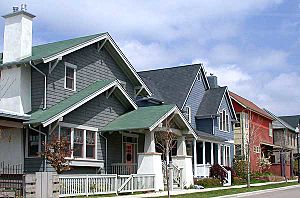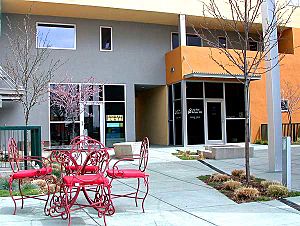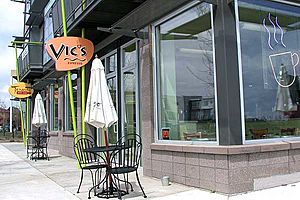Prospect New Town facts for kids
Prospect New Town is a special neighborhood in Longmont, Colorado, located in Boulder County, Colorado, United States. It's built using ideas called New Urbanism, which means it's designed to feel like an old-fashioned town. This neighborhood was one of the first big "New Urbanist" projects in Colorado. It started in the mid-1990s, led by Kiki Wallace. The design was created by Duany Plater Zyberk & Company, who also designed other famous New Urbanist places like Seaside, Florida and Kentlands. Prospect New Town is planned to have about 2,000 people living in different kinds of homes.
What is Prospect New Town Like?
This neighborhood was built on an 80-acre (about 32 hectares) tree farm that used to belong to Kiki Wallace's family. It's located near U.S. Highway 287. Prospect New Town mixes many different building styles, both old and new. This creates a unique and interesting look. Even though one company planned the overall design, many different architects designed the individual homes. They were encouraged to try out new and creative styles.
The neighborhood has a mix of businesses, single-family homes, row houses, and apartments. Some of the original farm buildings were kept and made part of the new development. This helps the area remember its past. Some new buildings look like traditional homes from the early 1900s. Others are very modern and unusual.
Prospect New Town follows the ideas of New Urbanism. This means it's different from typical suburban neighborhoods. It doesn't have huge front lawns or garages that stick out in front. Instead, homes have smaller yards and are closer together. This helps create a friendly, traditional neighborhood feeling.
The design also makes it easy to walk everywhere. There are sidewalks, and everything is close enough to walk to. Homes and lots here are usually smaller than in regular suburbs. A typical house might have about 5,100 square feet (470 m2) of living space on a 7,000 square foot (650 m2) lot. Homes in Prospect New Town have become quite popular, and their prices have gone up over time.
The neighborhood has a town center right in the middle of the homes. It has different businesses, like restaurants and offices. The streets are planned so you can see the mountains clearly. The town center is designed to be just a five-minute walk from anywhere in the neighborhood. It includes homes, stores, and offices, often with living spaces upstairs. This is like many older town buildings.
Because of its bright colors and unique buildings, some local people call Prospect "Toon Town."
How Prospect New Town Started
Kiki Wallace, who didn't like typical suburbs, owned the tree farm. He wanted to develop it in a nice way. He learned about New Urbanism from an article. Wallace then teamed up with Andres Duany (from DPZ) and local developer Dale Bruns. They started planning this special neighborhood in the mid-1990s. It was meant to be a test for traditional neighborhoods in Colorado.
The land offered great views of the mountains, including Longs Peak. The project was first called the "Wallace Addition" and "Burlington Village." It was planned to cost about 37 million dollars. The team also hired the Rocky Mountain Institute to help with using eco-friendly building materials. The plan included nine small parks spread throughout the homes and businesses.
Some homes have apartments above their garages. This is a traditional feature that lets people rent a place in the neighborhood. It also helps homeowners pay their mortgage. Another old-fashioned feature is the use of rear lanes. These were common in old towns but are often missing in suburbs today. Rear lanes help separate cars from people walking.
Like many New Urbanist projects, this plan faced challenges. It didn't fit many local zoning rules at first. Local fire and police departments worried about the narrow streets. The Colorado Department of Transportation thought there were too many driveways. Wallace, Bruns, and Duany worked hard in 1994 to convince local and state officials. This struggle is why the main road is called "Tenacity Drive."
Their hard work paid off. In 1995, the Longmont Planning Board approved the project. They said, "this is what people want." Longmont mayor Leona Stoecker strongly supported the project.
The first part of the project included 65 lots. By the time it was approved in 1995, Wallace had already sold 35 of them. This early success made other developers interested. A developer from Colorado Springs, Colorado started planning a similar project nearby. The city of Broomfield, Colorado also contacted a planner named Peter Calthorpe, who shares many New Urbanist ideas, to help design their community.






